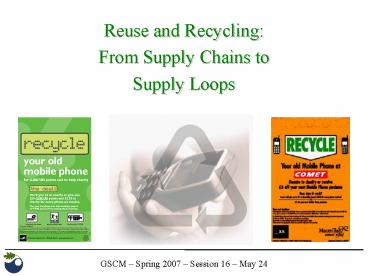Reuse and Recycling: From Supply Chains to Supply Loops - PowerPoint PPT Presentation
1 / 13
Title: Reuse and Recycling: From Supply Chains to Supply Loops
1
Reuse and RecyclingFrom Supply Chains to Supply
Loops
2
From supply chains to supply loops
Traditional supply chains end with the sale and
delivery of the final product
Raw materials mining
Primary materials production
Component manufacture
Final product assembly
Product sale and delivery
Lee Billington, for example, define a supply
chain as a network of facilities that
procure raw materials, transform them into
intermediary goods and then final products, and
deliver the products to customers through a
distribution system.
Product demand use
End-of-life product disposal
What happens to the product after sale and
deliveryis of no concern for supply chain
managers
3
Supply loops divert end-of-life products from
landfill and reprocess these products, their
components or their materials into secondary
resources which replace primary resources in
forward supply chains.
Raw materials mining
Primary materials production
Component manufacture
Final product assembly
Product sale and delivery
Product demand use
Component re- processing
Product re- processing
Materials re- processing
End-of-life product disposal
Eol product collection inspection
4
A supply loop is constrained when it is not able,
for technical or economic reasons, to reprocess
all targeted arising end-of-life products into
secondaryoutput that is marketable a above-cost
prices.
Raw materials mining
Primary materials production
Component manufacture
Final product assembly
Product sale and delivery
Product demand use
Component re- processing
Product re- processing
Materials re- processing
End-of-life product disposal
Eol product collection inspection
- The reasons can be
- Limited collection of end-of-life products
- Limited feasibility of reprocessing
- Limited market demand for the reprocessed
secondary resources
5
Case study Recycling and reuse of structural
steel sections in construction
6
Case study Recycling and reuse of structural
steel sections in UK construction
Use of buildings and other structures
BF Section production 350 / ton 28.5GJ / ton
Fabrication of sections 350 / ton 4.8GJ / ton
Use of sections in construction 250 / ton 2.0GJ
/ ton
EAF Section production 350 / ton 10.8GJ / ton
Re-fabrication of sections 350 / ton 4.8GJ / ton
Section recovery via deconstruction 100 /
ton 0.4GJ / ton
Section recovery via demolition 50 / ton 0.4GJ /
ton
- A survey of demolition contractors in 2001
reports that - 99 of all end-of-life sections were recovered
- 86 were recycled
- 13 were reused in some form
Landfill of sections 50 / ton 1.3GJ / ton
7
Environmental evaluation of supply loops for
steel sections
Factor 2
Factor 5
8
Economic evaluation of supply loops for steel
sections
9
Increasing the reuse rate of steel sections seem
to be a win-win scenario. Why is there not more
reuse of end-of-life steel sections?
10
Analysis of supply loop constraints for reclaimed
sections
- Observation
- Technical or operational feasibility of the
supply loop processes may be limited (hard
constraint) - Economic feasibility of the supply loop
processes may be limited (soft constraint)
- Constraints on section recycling
- Limited feasibility of demolition and separation
- Limited feasibility of section scrap
reprocessing - Limited market demand for sections from recycled
steel
- Constraints on section reuse
- Limited feasibility of deconstruction
- Limited feasibility of re-fabrication
- Limited market demand for re-fabricated sections
11
Analysis of supply loop constraints for section
reuse
Deconstruction cost and energy may increase with
the reuse rate
12
Analysis of supply loop constraints for section
reuse
Deconstruction and re-fabrication cost and energy
may increase with the reuse rate
13
Analysis of supply loop constraints for reclaimed
sections

